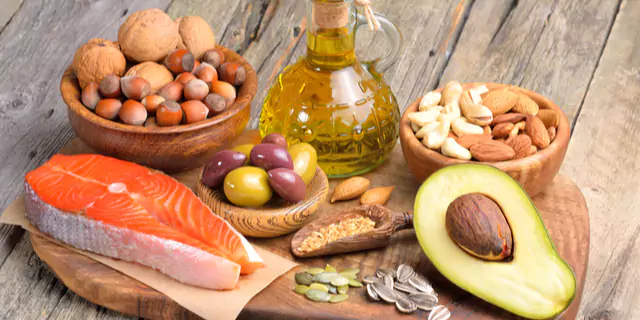Combining Foods to Lower Your Glucose Response [+ Examples to Help Steady Blood Sugar]

Key Takeways
The glycemic index (GI) is one of our favorite tools to assess the potential impact of carbohydrates on glucose. This information holds great significance for everyone, especially for individuals with blood sugar concerns. When it comes to managing your blood sugar levels, the key lies in controlling your glucose response. This is where combining certain foods plays a crucial role.
So how exactly do you combine foods to lower your glucose response? Let’s take a closer look at the glycemic index and how you can pair foods for blood sugar balance.
Principles of Low-Glycemic Eating to Live By
The glycemic index is a ranking system that estimates how carbohydrate-rich foods impact glucose. This ranks carbohydrate-rich foods on a scale from 1 to 100. It measures how quickly a carbohydrate is converted into sugar in the body. Each food is compared to pure sugar, which is rapidly digested, and assigned a value of 100 on the scale.
Foods that cause a rapid increase in blood sugar have a high number on the scale, while foods that have a slower effect have a lower number. Foods that quickly raise blood sugar have a high number, while foods that have a slower effect have a lower number.
This scale is useful, especially for people with diabetes or who are monitoring blood sugar, when choosing foods that maintain stable blood sugar levels. After all the foods are ranked, they're further divided into three categories:
- Low-GI Foods - a value of 55 or less
- Medium-GI Foods - a value between 56 and 69
- High-GI foods - a value of 70 or higher
Low-Glycemic Carbohydrate-Containing Foods
These carbohydrates cause only a small or moderate rise in blood sugar, which is why they are considered low glycemic. Some examples include:
- Whole Grains: Quinoa, brown rice, steel-cut oats, pasta, bulgar, barley, high-fiber bran cereal
- Legumes: Black beans, chickpeas, lentils
- Low-Starch Vegetables: Leafy greens, broccoli, cauliflower, mushrooms, carrots
- Nuts and Seeds: Almonds, walnuts, chia seeds
- Fruits: Blackberries, cherries, grapefruit, strawberries, oranges, apples, blueberries, plums, apricots
- Dairy Products: Milk and yogurt
Medium-Glycemic Carbohydrate-Containing Foods
These carbohydrates cause a moderate increase in blood sugar levels, making them suitable for occasional consumption or in combination with low-glycemic foods. Some examples include:
- Whole Grains: Whole wheat bread, pita bread, rye bread, couscous
- Starchy Vegetables: Sweet potatoes, corn, acorn squash
- Fruits: Bananas, pineapples, mangoes, pears, raisins
High-Glycemic Carbohydrate-Containing Foods
These carbohydrates cause a sharp rise in blood sugar levels due to their high glycemic index. Some common foods examples include:

- Refined Grains: White bread, white rice, bagels, instant oat breakfast cereals, bran flakes
- Starchy Vegetables: Potatoes, parsnips
- Fruits: Watermelon, overripe bananas, raisins
- Sugar-Sweetened Foods and Drinks: Soda, candy, cookies, cakes, fruit juice
- Processed and Packaged Snacks: Chips, crackers, granola bars, energy drinks
Tips on What Foods to Eat
Eating Non-Starchy Vegetables, Beans and Fruits
These are some of the best foods available to health-conscious people in general since they're packed with nutrients and fiber. They also pull double duty as low glycemic index foods due to the lack of starch, which can help people struggling with weight control.
Examples
- Kidney beans
- Butter beans
- Lentils
- Grapefruit
- Pear
- Broccoli
- Cauliflower
Enjoy Less-Processed Grains
Grains are a staple food in many breakfasts, so it's even more important to get this one right. What you eat for breakfast can affect your energy levels and appetite for most of the day.
If you are someone who consumes grains, then you want to focus on a whole grain version with more fiber content. The less processed a grain is, in general, the longer it'll take to digest and the longer you'll feel full.
Examples
- Steel cut oatmeal
- Quinoa
- Buckwheat
- Khorasan wheat
- Brown rice
Of course, not everyone tolerates grains well, particularly those that contain gluten. If this applies to you, then some grains without gluten like quinoa and buckwheat may be the best options to consider.
Limit Sweets (Even if Low on the GI)
Sweets and desserts often contain simple sugars, like table sugar, brown sugar, and high-fructose corn syrup. These simple sugars are quickly broken down and absorbed into the blood, which can lead to a sharp rise in glucose levels.
While sweet treats can be a part of a balanced diet, it’s important to practice moderation and mindfulness when eating these foods.
Examples
- Lollipops
- Caramel
- Gumballs
- Marshmallows
- Candies
- Icing
- Sugary drinks
Stick to Eating Healthy Proteins
Processed protein options, like protein bars and premade protein shakes, may contain a large amount of added sugars. Opt for unprocessed protein sources.

Examples
- Grass-fed beef
- Chicken
- Turkey
- Wild game
- Fatty fish, including sardines and salmon
- Pasture-raised eggs
Don't Forget About Watching the Fatty Foods
You may think that oily foods probably don't have much carbs. However, if high fat foods are paired with high carb foods, you may see a larger blood sugar response. That’s because the fats tend to slow down digestion, making the sugar stay in the bloodstream longer.
Some of the fatty foods to watch out for include:
- Fried Foods: French fries, onion rings
- Processed Meats: Sausages, bacon, salami
- Creamy Sauces: Alfredo sauce, ranch dressing
- Sweet Treats: Cookies, cakes, pastries
- Drinks: Milkshakes, sweetened coffee drinks, boba tea
Consume Healthy Fats
Healthy fats are an essential part of a balanced diet. It's a crucial detail that eating fats doesn't make you fat. While fats can contribute to weight gain if eaten in excess , they also help stabilize the release of sugar into the blood over a more extended period. So when you eat healthy fats with a meal, you reap the benefits of a less blood sugar spike and a more drawn-out release of energy.
Examples of Healthy Fats
- Avocados
- Olive oil
- Olives
- Walnuts
- Peanuts
- Hemp seeds and oil
Unprocessed Foods vs. Processed Foods
You may come across the term "processed foods" often while researching diabetes and diet. But what exactly does it mean? To a certain extent, many of our foods are somewhat processed. For example, cutting up a fruit or vegetable can be considered processed.
However, what health experts and scientists refer to as "ultra-processed foods" are foods that have been severely altered from their original state. These food items also often contain added sugars, unhealthy fats, and high levels of sodium.
These can include:
- Canned fruits and green vegetables
- Packaged snacks such as chips, cookies, rice cakes, candies
- Packaged juice such as orange juice, apple juice, and grape juice
- Ice cream
- Frozen meals
- Sugary breakfast cereals, raisin bran cereal, corn flakes
- Processed meats
- White bread and other bakery products such as cakes, muffins, and doughnuts
- Sauces such as barbecue sauce, ketchup, ranch dressing
- Nuts and seeds with added sugar or salt, such as chocolate-coated macadamia nuts, salted almonds and pumpkin seeds, honey peanuts
- Beyond meat products
If you are wondering why you can't seem to reach a healthy weight or reach your blood sugar goals when you're eating organic or "healthy" packaged foods, this could be why. Although marketed as healthy options, these foods can still significantly impact your blood sugar and overall health due to the added sugars and unhealthy fats they contain.
While these "healthy" packaged foods may be more nutritious than others, they're still not as healthy as the processing lowers the nutritional content of the ingredients while increasing salt, sugar, and other additives. So, instead of relying on these processed options, try incorporating more unprocessed or minimally processed food choices such as:
- Fresh fruits and vegetables
- Frozen fruits and vegetables without added sauces or seasonings
- Whole grains like brown rice, quinoa and oats
- Plain yogurt
- Hemp seeds, flax seeds, chia seeds
- Lean proteins like chicken breast, fish and tofu
- Healthy fats like avocados and nuts without added sugar or salt
- Plant-based options like beans, lentils, and legumes
What Is a Glycemic Load?
Glycemic load (GL) takes the glycemic index a step further by taking into account both the quality and quantity of carbohydrates consumed. This is important because it allows us to have a better understanding of how much of an impact certain foods will have on our blood sugar levels.
GL measures the overall absorption of sugar into our bloodstream after eating a particular food, considering its GI value and total carbohydrate content. The formula for calculating GL is:
GL = (GI x Carbohydrate content in grams per serving) / 100
For example, a medium-sized apple has a GI of 38 and contains about 15 grams of carbohydrates. Therefore, its GL would be calculated as (38 x 15) / 100 = 5.7.
In recent research, it has been suggested that keeping track of both GI and GL can be beneficial for managing blood sugar levels and reducing the risk of chronic diseases such as diabetes, heart disease, obesity, and other metabolic diseases.
The Importance of Portion Control
Eating a balanced diet is key to managing diabetes, but portion control is also crucial. Overeating even healthy foods can lead to blood sugar imbalances and weight gain. After all, even if you're on a low-glycemic diet, if you consume more calories than you burn, weight gain is inevitable.
Here are some tips for controlling portions:
- Use smaller plates: This helps with visual cues and can prevent overeating.
- Measure out servings: Pay attention to serving sizes listed on the packaging and use measuring tools like cups and spoons to ensure accurate portions.
- Eat slowly: It takes about 20 minutes for your brain to register that you are full, so eating slower can help prevent overeating.
- Don't multitask while eating: Being distracted while eating can lead to mindless overeating, so try to focus on your food and enjoy each bite.
- Keep track of portions in recipes: If you are cooking at home, be mindful of portion sizes and adjust accordingly.
Try Sticking to 3 Meals Per Day
If you eat a smaller number of meals, but those meals contain whole foods, including vegetables, proteins, and some starches, it should keep you from needing to snack throughout the day. There's a metabolic component here: combining starches with foods that are slower to digest will mean the sugar is released more slowly into the blood.
While the occasional snack is fine, there's also a behavioral component. It's simply easier to track the food you eat when it's done less often, and you'll be less prone to topping up energy levels as they start to dip, which can make you feel hungrier and lead to more frequent glucose spikes.
Importance of Combining Low Glycemic Index Carbohydrates with a Protein or Fat

Combining foods rich in proteins, fats, and low-glycemic carbs can aid weight loss and blood sugar management while offering additional benefits. Plus, eating balanced meals covering all food groups can also make meeting nutritional needs easier.
Not only can a well-rounded diet that pairs these macronutrients together help maintain healthy blood sugar levels, but it may also reduce the risk of type 2 diabetes for some people. A well-rounded diet with lean proteins, fiber, and healthy fats can support heart health and prevent chronic disease.
Although more research is required on food combinations, pairing a balanced diet with a healthy lifestyle and regular exercise is shown to have positive benefits overall health.
Examples of Low Glycemic Index Food Combinations with Healthy Proteins
- Chicken and brown rice with squirts of lemon juice for flavor
- Turkey in tomato sauce
- Venison and shallots
Examples of Low Glycemic Index Food Combinations with Healthy Fats
- Full-fat Greek yogurt and berries
- Steel-cut oatmeal with flaxseed and grass-fed butter
- Apple with almond butter
Engage with Your Blood Glucose Levels with Nutrisense
Understanding the ebb and flow of your blood sugar levels is like unlocking the secret to your body's unique rhythm, illuminating the path to optimal health and vitality. That's the beauty of stable glucose levels — they form the foundation for long-lasting health and overall well-being.
The Nutrisense CGM program provides an in-depth look into your blood sugar levels, giving you the power to make informed decisions about your lifestyle and dietary choices. You'll be surprised by the positive changes you can make just by being more mindful of your meal planning and blood sugar levels.
Rest assured, you're never alone on this path. Our team of dedicated nutritionists is here to walk alongside you, sharing their expertise, celebrating your victories, and providing gentle guidance when needed. Together, we'll uncover the unique patterns of your body and work towards optimal health, one step at a time.
Are you ready to illuminate your journey to health with Nutrisense? Let's begin with a spark of curiosity — take our quiz and uncover how Nutrisense can be your guiding light towards a life in full color. Your adventure towards vibrant health starts now.
Find the right Nutrisense programto turn insight into progress.
Go Beyond Glucose Data with Nutrisense
Your glucose can significantly impact how your body feels and functions. That’s why stable levels are an important factor in supporting overall wellbeing. But viewing glucose isn't enough. Nutrisense, you’ll be able to learn how to use your body's data to make informed lifestyle choices that support healthy living.
One-to-one coaching
Sign up to access insurance-covered video calls to work with a glucose expert: a personal registered dietitian or certified nutritionist who will help tailor your lifestyle and diet to your goals.
Monitor and measure what matters
With the Nutrisense CGM Program, you can monitor your glucose with health tech like glucose biosensors and continuous glucose monitor (CGM)s, and analyze the trends over time with the Nutrisense App. This will help you make the most informed choices about the foods you consume and their impact on your health.
Find your best fit
Ready to take the first step? Start with our quiz to find the right Nutrisense program to help you take control.

Kara Collier is a registered dietitian nutritionist and certified nutrition support clinician who is passionate about reshaping how we approach prevention, behavior change, and metabolic health. A Forbes 30 Under 30 honoree, she’s helped over 150,000 people improve their metabolic health using tools like continuous glucose monitors and behavior-focused nutrition strategies. Kara has been featured by Forbes, UC Berkeley, and HLTH, and has appeared on top podcasts like Mind Pump and The Genius Life.




